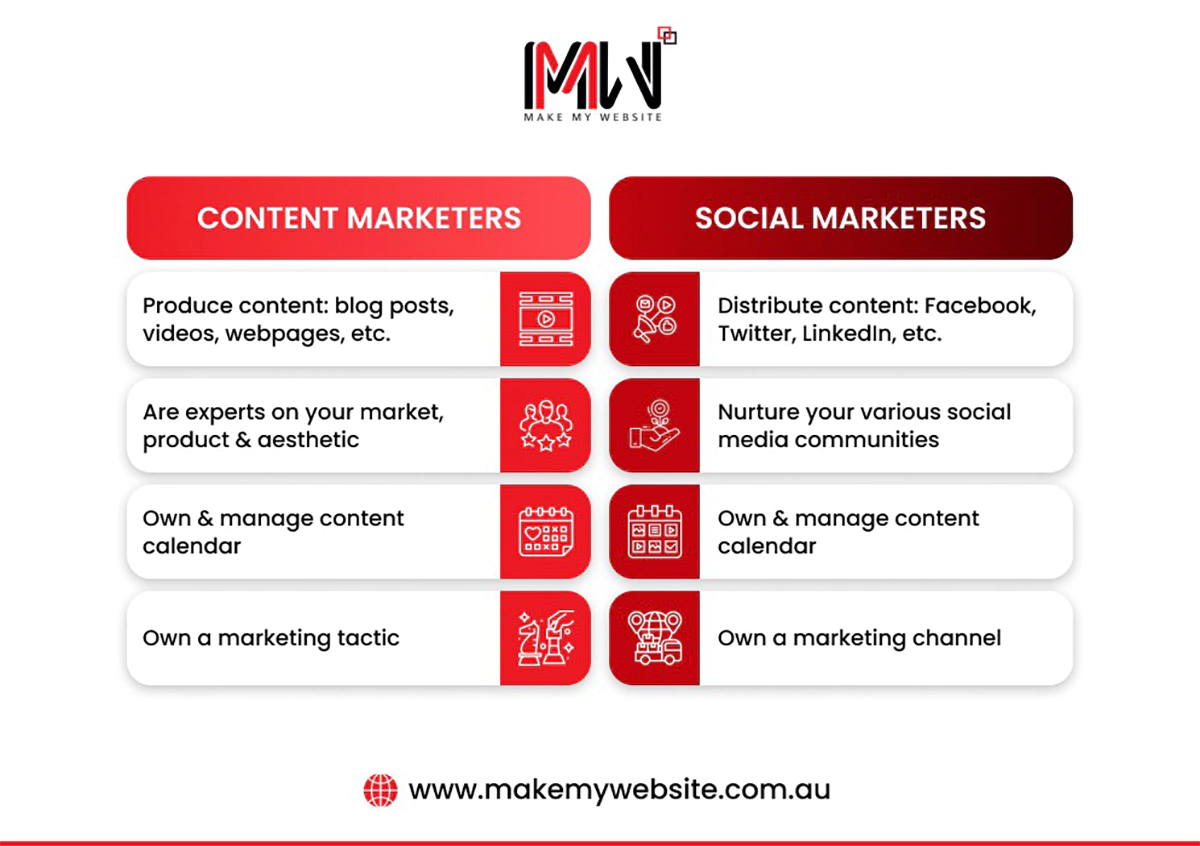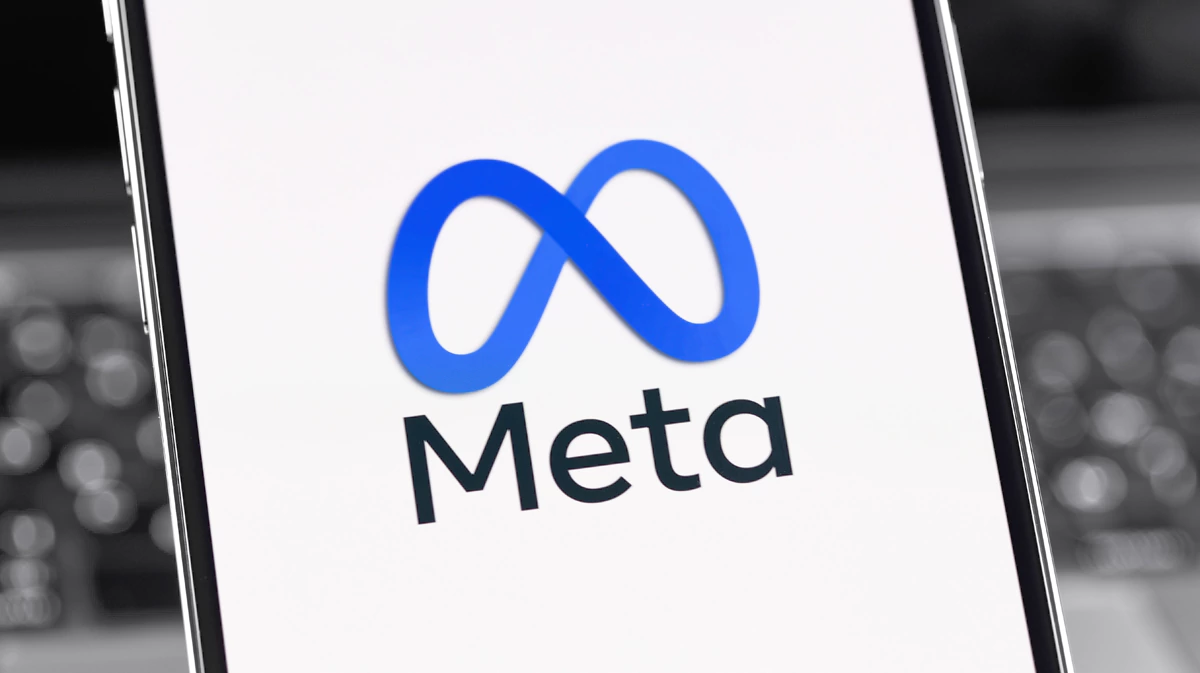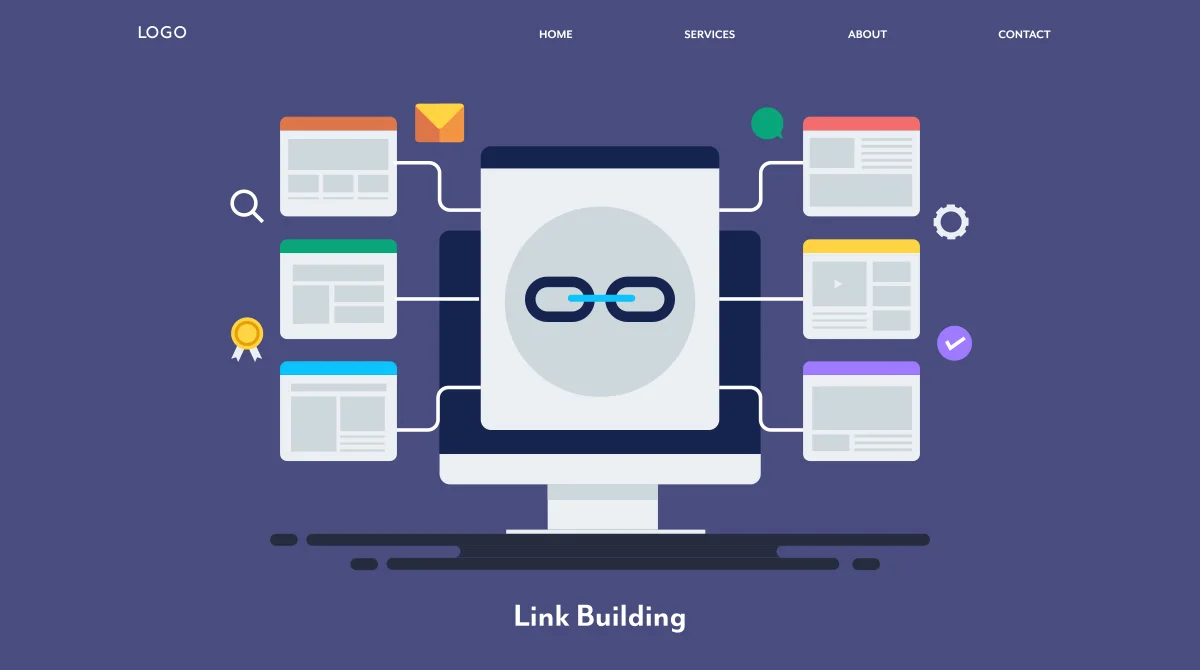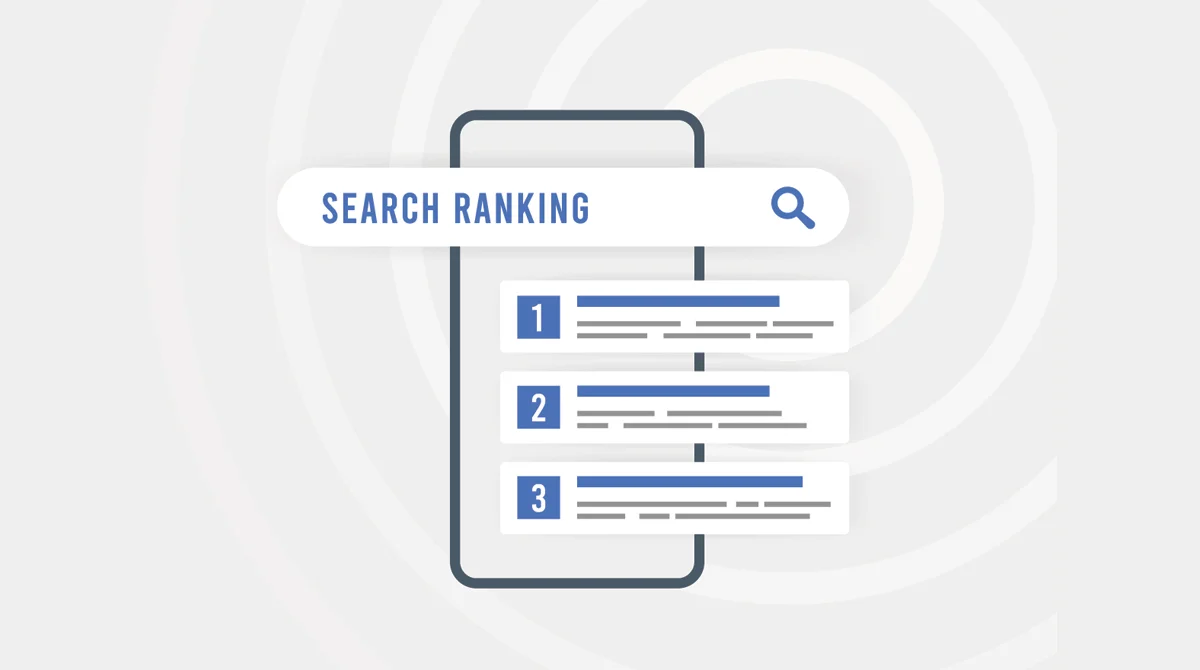The modern business struggle to deliver effective outreach towards their intended consumer base. Multiple marketing strategies create an overwhelming sense in the marketplace. The two principal marketing methods, content and social, involve frequent errors of mistaken identity, resulting in unfulfilled potential and wasted company resources.
Consider investing significant time creating comprehensive blog articles, only to observe sparse visitor numbers due to a lack of social media promotion. A successful social media campaign that leads to high audience interaction could turn into an unsuccessful conversion effort when followers do not believe in your brand. Businesses’ failure to distinguish between these tactics leads to unmet marketing targets.
The blog presents the fundamental differences between content and social media marketing to teach you both strategies’ practical applications. Your strategic roadmap will allow you to use both methods effectively so your marketing activities achieve short-term results together with long-term expansion.
What is content marketing?
Content marketing entails an organised, long-term method of designing and distributing helpful content to its target audience. The purpose of content marketing remains focused on drawing particular audiences through continuous valuable content delivery. Building trust and establishing credibility is the primary goal to encourage actions from customers that bring benefits to businesses over extended periods. The strategy presents valuable content instead of pushing product promotions, which traditional advertising methods typically use.
Core components of Content Marketing include:
1. Educational Content
The educational content helps support the audience by resolving their issues, answering their questions, and delivering valuable insights. By establishing yourself as a reputable source, you will gain loyal customers by developing your brand reputation.
Examples:
- The thorough guide from Moz titled Beginner’s Guide to SEO presents basic SEO information to beginners.
- The Design School at Canva provides users with cost-free tutorials on graphic design through which they can develop new abilities and become familiar with Canva features.
Why It Works:
- Establishes trust by offering value without seeking immediate rewards.
- The establishment of your brand as an industry expert happens through this move.
- The application implements SEO methods that drive natural website traffic.
2. Authority-Building Content
When your content presents researched expertise, your brand can gain a trustee position as an authority in its field. The content is a valuable magnet for key audience sectors such as industry specialists and decision-making personnel.
Examples:
- The McKinsey Global Banking Annual Review is a complete research document that examines banking dynamics and assists international executives with their decision-making processes.
- As part of their yearly effort HubSpot releases the State of Marketing Report to give insights to marketers.
Why It Works:
- Draws in influential audiences, such as decision-makers and industry experts.
- Creates backlinks and media attention, enhancing search engine optimisation.
3. Entertainment-Driven Content
Entertainment-centred content captivates your audience emotionally through storytelling, humour, or visually engaging material. It crafts unforgettable experiences that connect with your audience.
Examples:
- Through their “Stratos” livestream broadcast, Red Bull presented Felix Baumgartner’s stratospheric jump, which attracted many people and reinforced the brand’s thrilling identity.
- New content provided by Netflix builds a stronger fan connection to “Stranger Things” by revealing exclusive footage that shows how the show was made.
Why It Works:
- Establish emotional ties, making your brand unforgettable.
- Promotes sharing and increases your audience, broadening your influence.
4. Evergreen Content
Evergreen content offers enduring value, staying pertinent without a specific expiration date. This minimises the demand for continual content production and results in a steady traffic flow over an extended period.
Examples:
- Wikipedia articles are valuable resources that attract millions of search queries over time.
- Backlinko’s SEO guide maintains its ability to generate traffic years after its release due to its enduring relevance.
Why It Works:
- Lowers the necessity for ongoing content production.
- Creates steady traffic and leads over an extended period.
Why Content Marketing Matters
- Builds trust by offering value first, encouraging loyalty and confidence.
- Increases organic traffic as search-engine-friendly content ranks higher and attracts quality visitors.
- Supports lead development with informative content that helps guide potential customers through their buying decisions.
- Offers a cost-effective solution, requiring 62% less investment than traditional marketing while producing three times more leads.
What is social media marketing?
Social media marketing enables companies to reach customers through Instagram, TikTok, LinkedIn, Facebook and X (previously Twitter). It focuses on direct interaction, building communities, and driving instant actions like likes, shares, comments, or clicks. Compared to content marketing, it is often more interactive and time-sensitive.
The Core Components of Social Media Marketing are:
1. Paid Advertising
Paid advertising helps brands reach specific audiences through targeted ads. It ensures visibility and maximises return on investment with advanced targeting features.
Examples:
- Fashion Nova uses carousel posts on Instagram to display outfits and link directly to their product pages.
- Airbnb creates Facebook ads highlighting unique accommodation options tailored to travellers based on their search history.
Why It Works:
- Algorithms prioritise paid content to improve visibility.
- Precise targeting options such as demographics and interests help increase return on investment.
2. Community Engagement
Community engagement cultivates mutual dialogue, strengthening loyalty and trust. It converts passive followers into enthusiastic brand ambassadors.
Examples:
- Starbucks’ #RedCupContest invites people to share their holiday cup designs, creating user content and building enthusiasm.
- Glossier strengthens connections by responding to Instagram comments, helping followers feel included and valued.
Why It Works:
- Active communities promote your brand by sharing it with others.
- They build trust by showing your brand listens and cares.
3. Trend-Driven Content
Content-based on current trends uses popular moments to stay relevant and increase visibility, showing your brand is aware and relatable.
Examples:
- Duolingo’s TikTok account uses trending sounds and memes to make the brand appear more approachable.
- Wendy’s “Roast Tweet” campaign mocked competitors, gaining over 2.4 million retweets within 24 hours.
Why It Works:
- Using trends can increase visibility among younger audiences.
- It shows your brand understands the current culture and stays relevant.
4. Customer Service
Companies foster trust and transparency by handling customer service issues publicly on social media. This approach transforms negative experiences into opportunities to showcase the brand positively.
Examples:
- JetBlue’s Twitter team replies to customer complaints within minutes, demonstrating quick and efficient service.
- Zappos’ social media support is recognised for its exceptional efforts in resolving customer problems.
Why It Works:
- Engaging with the public shows responsibility and concern.
- It can turn bad experiences into positive impressions of the brand.
Why Social Media Marketing Matters
- Expand Brand Awareness: Social media connects businesses with billions of users, reaching a massive audience.
- Encourages Instant Interaction: Real-time actions like likes, shares, and comments raise awareness and attract attention.
- Fosters Loyal Communities: Engaged followers often become repeat customers and passionate brand supporters.
- Creates Fast Outcomes: Viral content and paid promotions can quickly increase website traffic and boost sales.
Key differences between content marketing vs. social media marketing
The following table underscores the primary distinctions between content marketing and social media marketing across four crucial aspects:
| Aspect | Content Marketing | Social Media Marketing |
| Focus and Purpose | Long-term education and trust-building. | Immediate engagement and virality. |
| Timeframe for Results | Months to years (e.g., SEO-optimised blogs). | Hours to weeks (e.g., viral posts). |
| Content Types | Long-form blogs, whitepapers, webinars. | Short-form posts, Stories, and Reels. |
| Cost Considerations | High upfront cost, long-term ROI. | Variable costs (e.g., ads, influencers). |
Not sure about the difference between content marketers and social marketers? Check out our infographic—it’s a quick, visual guide to help you understand their unique roles and how they can work together for your business!
Developing a complete marketing strategy requires understanding how content marketing differs from social media marketing practices. The two approaches exhibit substantial differences regarding focus, time extent, content types, and spending methodologies. A comprehensive analysis of each element is presented below:
1. Focus and purpose
Content Marketing
- Focus: Content marketing revolves around producing meaningful, helpful, and lasting content that gradually meets audience needs and earns trust.
- Purpose: Its core purpose stands to impart knowledge while developing credibility and genuine connections between the speaker and audience members.
Example:
- Free marketing sales and customer service guides under HubSpot’s Blog help establish the company as a reliable source of information.
- The Creative Insider Blog from Adobe provides tutorials and design guidance that suggest subtle ways of using Adobe software products.
Why It Works:
- Earns trust by offering value without expecting anything in return.
- Build your brand into an expert leader in your business domain.
- Boosts organic website traffic through effective SEO practices.
Social Media Marketing
- Focus: Social media marketing highlights instant interaction, building communities, and actions like likes, shares, and clicks.
- Purpose: The primary goal is increasing brand recognition, driving interaction, and achieving quick sales or sign-ups.
Example:
- Wendy’s “Roast Tweet” campaign used humour to criticise competitors, gaining over 2.4 million retweets in 24 hours.
- Nike’s Instagram shares motivational stories and user-created content, boosting engagement and sales.
Why It Works:
- Promotes sharing, helping you reach more people.
- Fosters a sense of connection and loyalty.
- Encourages immediate actions like clicks or purchases.
2. Timeframe for results
Content Marketing
Timeframe: Content marketing focuses on long-term goals, often delivering outcomes over several months or years.
How It Works:
Blogs optimised for SEO and evergreen articles take time to rank but steadily increase traffic over the long term.
Example: Backlinko’s “SEO Tools Guide” continues to receive 50,000 monthly visitors throughout multiple years since it first went live.
ROI:
- Content marketing is 62% cheaper than traditional advertising and produces three times more leads.
- Evergreen content reduces the need for frequent new material, providing ongoing value.
Social Media Marketing
Timeframe: Social media marketing produces quick results, often showing impacts within hours or days.
How It Works:
Viral content, popular hashtags, and timely campaigns can boost engagement and sales.
Example: Amazon’s Prime Day promotions on X (formerly known as Twitter) resulted in $12.7 billion in sales over 48 hours.
ROI:
- According to Buffer, 73% of marketers find social media marketing “somewhat effective” for sales.
- Paid advertisements and influencer partnerships can bring immediate returns but require consistent spending.
3. Content types and formats
Content Marketing
Content Types:
- The long-form content consists of articles that reach 2,000 words or longer, with whitepapers, e-books, and case studies.
- Most evergreen articles contain tutorials alongside how-to guidelines and Frequently Asked Questions for long-term value.
- The content collection of multimedia features a combination of webinars, podcasts, and video series.
Examples:
- The Merchant Stories platform from Shopify presents demonstrations of thriving business success stories.
- Salesforce’s State of Marketing Report provides data-driven whitepapers designed for B2B decision-makers.
Why It Works:
- Long articles perform well in search results, helping to increase organic traffic.
- Timeless content offers ongoing value and reduces the need for frequent updates.
Social Media Marketing
Content Types:
- Short-form content consists of Twitter Tweets and Instagram Stories with the addition of TikTok videos and Instagram Reels within the platform.
- The interactive approach in content delivery consists of polls, quizzes, and live Q&A sessions.
- Trend-based content features memes, challenges, and hashtag campaigns.
Examples:
- Netflix promotes its upcoming shows through brief, engaging video clips on Instagram Reels.
- The quiz platform BuzzFeed brings users in with “Which Disney Princess Are You?” to increase user interaction.
Why It Works:
- Short content is quick to read and share, which makes it perfect for campaigns that spread widely.
- Interactive content encourages active engagement, helping to create connections and strengthen loyalty.
4. Cost considerations
Content Marketing
Upfront Costs:
- Creating content often requires a significant upfront investment, such as hiring writers, producing videos, or using SEO tools.
- For instance, maintaining Ahrefs’ blog costs approximately $15,000 monthly but generates over 2 million organic visits.
Long-Term Value:
- Evergreen content lowers the cost per lead over time.
- For example, Zendesk’s Help Centre ranks for over 500,000 keywords, helping to reduce customer service expenses.
ROI:
Content marketing produces three times as many leads as paid advertisements, costing 62% less.
Social Media Marketing
Variable Costs:
Paid ads: 0.50–0.50–2.00 per click (Meta).
Influencer collaborations:
10–10–50k/post for macro-influencers.
Ongoing Investment:
- A marketing strategy based on advertising needs continuous investments in advertisements that include content development and influencer collaboration.
- Through influencer marketing, Gymshark dedicates 30% of its budget, resulting in revenue composed primarily of 90%.
ROI:
Social media marketing performance in short-term campaigns depends on repeated investment for effective outcomes.
Content marketing vs. social media marketing: When to use each
Your primary marketing strategy depends on your specific goals, your target audience interests, and the result duration you need to achieve. The following scenarios provide detailed guidance to assist you in determining which strategy to emphasise.
Understanding your marketing objectives
Your marketing objectives are essential in deciding which strategy to implement. Here’s how to match each strategy with typical goals:
Brand Authority:
- Produce research papers or detailed reports to demonstrate expertise and authority in your industry.
- For example, IBM’s “Global C-suite Study” showcases the company’s knowledge of business strategy and insights.
- Avoid shallow posts on social media, as they often lack substance and fail to build credibility.
Lead Generation:
- Content Marketing: Use lead capture forms to provide access to e-books or webinars.
- Example: HubSpot’s “Lead Generation Toolkit” generates thousands of leads annually.
- Social Media: Create LinkedIn lead-generation ads focused on specific job titles.
Crisis Management:
- Social Media: Address problems openly to demonstrate honesty and show you’re listening to concerns.
- Example: KFC turned a chicken shortage into a success with their “FCK” apology ad.
- Avoid Content Marketing: Delays in responding can make crises worse.
Identifying your target audience and their preferences
Comprehending your audience’s favoured inclinations is crucial for selecting the appropriate strategy. Here’s how to customise your method:
B2B Audiences:
- Content marketing uses webinars, case studies, and whitepapers to reach professionals effectively.
- For example, Zoom’s “Future of Work” series draws the attention of business leaders.
- On social media, thought leadership posts on LinkedIn effectively engage key decision-makers.
B2C Audiences:
- Content Marketing: Blogs with recipes, step-by-step guides, and entertaining videos perform well with audiences.
- Example: Tasty’s viral food videos capture the attention of cooking enthusiasts.
- Social Media: TikTok challenges and Instagram Stories encourage engagement and interaction.
- Example: Chipotle’s #GuacDance campaign gained widespread attention and increased sales.
Consider long-term vs. short term-results
Your results’ timeline should also shape your strategy. Here’s how to find a balance between the two:
Long-Term Goals:
- Focus on creating timeless content that drives steady traffic.
- Example: Zendesk’s Help Centre ranks for over 500,000 keywords, cutting customer service costs significantly.
- Budget Tip: Dedicate 30% of your resources to long-form, SEO-friendly content.
Short-Term Goals:
- Social Media: Run time-limited campaigns to encourage quick action.
- Example: Dunkin’s Pumpkin Spice promotion generates 20% of yearly revenue in the fourth quarter.
- ROI Tip: Use Instagram Stories ads for short-term sales or exclusive offers.
Transform Your Marketing Strategy with Make My Website
Tackling the intricacies of content and social media marketing can feel overwhelming, but you’re not in this alone. At Make My Website, we excel in developing customised marketing strategies that merge the sustained influence of content marketing with the instant results of social media marketing.
Here’s what we can do for your business:
- Content Development: Our specialised team will produce top-tier, search engine-optimised content that establishes your brand as a leading authority in your field.
- Social Media Oversight: We will design captivating, trend-focused campaigns that elevate your profile and stimulate immediate audience interaction.
- Unified Approaches: By coordinating your content strategy with your social media activity, we guarantee your marketing achieves immediate results and sustained expansion.
For building trust, driving traffic, or enhancing conversions, Make My Website offers the necessary tools and expertise to ensure your success. We will revamp your marketing strategy and advance your business to a higher level.Ready to partner up? Contact Make My Website today, and together, we’ll unleash the full potential of your marketing strategy!





















